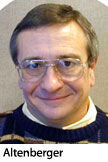By Paula Schlueter Ross
In its quest to bring the Gospel of Jesus Christ to at least 50 million “unchurched” North Americans over the next 12 years through Ablaze!, LCMS World Mission will be depending on the participation of congregations that baptize, confirm, and add names to their membership rolls each year.
After all, they’re the ones with outreach-focused ministries, right?
But the Synod’s national mission leaders say they also will be counting on at least 2,000 of the church body’s static or declining congregations (in terms of numerical growth) to turn their ministries around as part of the Ablaze! effort.
“Our goal is to have a minimum of 2,000 congregations by 2017 that are revitalized,” said Rev. Roger A
Statistics indicate that more than half of the Synod’s 6,100 congregations confirmed just one — or no — adults in the past year, according to Altenberger. And those aren’t just rural churches — they’re situated “all over the place” in cities and suburbs as well as in rural areas, he says.
“God desires all of us to be missional, and in most of these cases people have just forgotten what their first love was and why they existed as a congregation to begin with,” says Altenberger. He sees the church revitalization post as helping declining congregations “get back to where they were in the beginning” of their ministries.
Altenberger has been one of three executives working together as part of LCMS World Mission’s “National Mission Team” to implement Ablaze! in North America. Succeeding him as director of church revitalization is Rev. David Born, LCMS World Mission’s regional director for the Northeast Region of the United States.
The team also includes Rev. Yohannes Mengsteab, who’s charged with encouraging a new wave of church planting, and Rev. Scott Snow, who wants to convince all Missouri Synod Lutherans that they can — and should — share their faith with others.
Altenberger may have had the toughest job of the three, but, like his counterparts, he believes Ablaze! goals are not only “doable,” but “small” in God’s eyes. As dying congregations once more begin to thrive, he expects their success stories to encourage others in similar straits to seek help, too.
Working with a dozen LCMS districts in a pilot project last summer, Altenberger helped develop and train leaders for a six-week Bible study called “Motivation for Mission” that’s designed to “shift a congregation’s spiritual paradigm.” After completing the course, congregations will have to decide “whether to become missional or continue business as usual,” he said.
Participating districts identified 255 declining congregations that are being invited to take part in the Bible study and its follow-up component, “Groups Ablaze!,” a small-group process for building an outreach-focused congregation.
So far, every congregation that has begun the process has been receptive, according to Altenberger, and those that have applied its principles to their own situations “have seen an increase in worship attendance, they [now] have adult confirmations, they’re engaged in their community, and more people in the congregation are involved in witnessing activities” — characteristics of a healthy, outreach-focused congregation, he says. “It’s just changing hearts and changing minds to see that the lost are the most important” focus.
The process is relatively inexpensive — about $60 for materials — and Altenberger encourages interested congregations to contact his successor, Rev. David Born, for information.
“The more people who are involved, the more opportunities we’ll have to reach 100 million people [through Ablaze!],” he said.
For information, contact Born at (800) 433-3954 or david.born@lcms.org.
Planting more churches
As LCMS World Mission’s director for new mission fields development, Rev. Yohannes Mengsteab sees his role as “helping healthy congregations replicate themselves.”
Working with LCMS mission leaders, districts, and mission societies, Mengsteab has begun a process to identify 600 “healthy” Synod congregations that will
Do the math and you can see that the plan would effectively meet the Ablaze! goal of starting 2,000 congregations in North America by 2017.
Mengsteab notes that this isn’t the first time the Synod has set an aggressive church-planting goal. “We had a similar vision in 1979,” he said. “The goal was to plant 1,800 congregations in 10 years,” or about 180 a year. The actual number of churches started was less than 100 a year — 70 to 80, according to Mengsteab.
In his opinion the effort was not successful because the Synod failed to “clearly connect church planting and leadership development” — the strategy it uses in overseas mission fields. In effect, the church body was increasing the workload without increasing the manpower, with an expectation Mengsteab calls “unrealistic.”
This time around, lay leaders in each of the chosen congregations will be trained as “church planters.” Their theological education will be modeled after the Ethnic Immigrant Institute of Theology, a distance-education program based at Concordia Seminary, St. Louis, that trains immigrants — mostly Africans — as missionaries in less than four years.
The new missionary-training program, which Mengsteab hopes will be in place by this summer at both LCMS seminaries, has been dubbed “Missionary Pastor Leadership Development.” Traditional mission-track seminary students also will be recruited as church planters, as well as deaconesses and other professional church workers, according to Mengsteab. And a number of congregations may choose to put together “church-planting teams” of several people — rather than just a single person — to guide their efforts.
Without additional church planters, church-planting goals simply cannot be met, he says, and he

